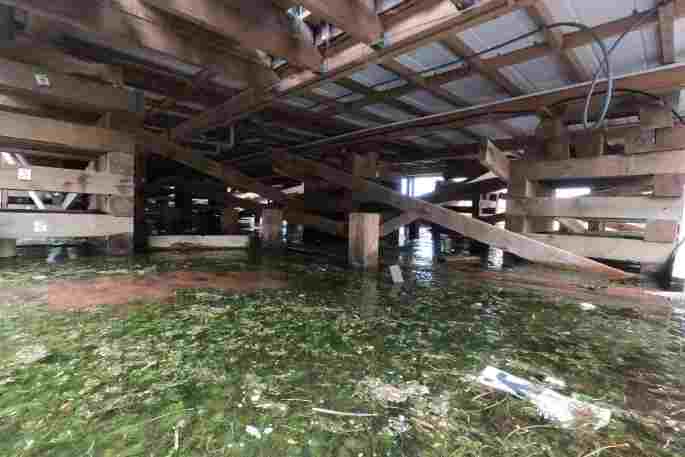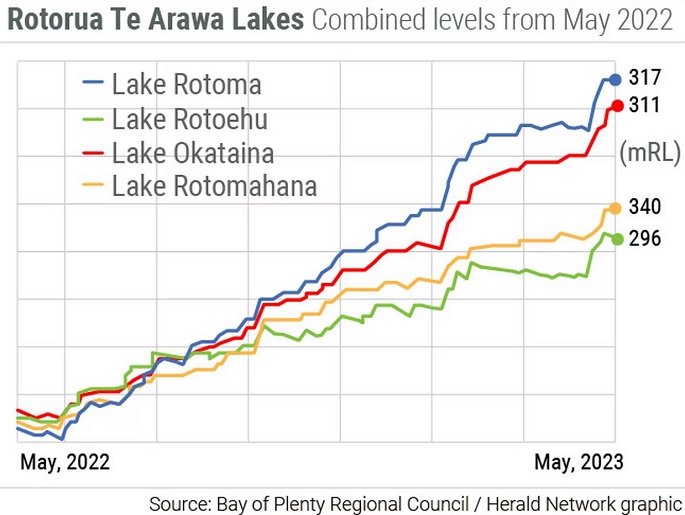Rotoehu homeowner Joan Blair has gone from living her dream to her worst nightmare.
She is among those in the small lakeside community near Rotorua with water lapping at her doorstep.
She and her husband John's Kennedy Bay holiday home was meant to be their retirement paradise but in the year since they bought it, the lake has risen two metres to a near-record high, and the home was surrounded.
The Tauranga couple paid $30,000 to raise the piles last week in a last-ditch attempt to save the house. It worked in keeping the interior dry, but they believed the house was not yet liveable with the lake still so high.
The threat of the water rising further weighed heavily on their minds with the likelihood of more rain over winter. And while neighbouring Lake Rotomā had not reached the point of overflow, water had seeped into Rotoehu, filling it further.
When they bought the property in March last year, they saw no red flags, Blair says. The LIM report showed no issues, and as far as she was aware there was no history of flooding.
Now, she is terrified and worried with changing weather patterns, the water would never recede.

Water has swamped the ground beneath Joan Blair's Rotoehu home. Photo: Laura Smith.
'Basically our dream retirement home has become our worst nightmare.”
She said the Rotorua Lakes Council had yet to assess the home but in her view: 'The house is uninhabitable ... it's not fit for living in.”
A council spokesman said it was aware of six homes in the Rotoehu-Rotomā catchment, and one Rotoehu business premises, that had been inundated.
'[The] council has not deemed any homes uninhabitable.”
Neighbour Larry Carne owns the property two doors down from the Blairs and has been working to waterproof the holiday home where possible, including by placing a protective layer between the piles and floor from underneath the house.
He described the slowly worsening situation as a 'death by millimetres”.
'Every time it rains you can barely tolerate it.”
The Blairs were helping drop off water-weighted barriers to try and keep lake waves from causing damage.
Roading concerns associated with the high lake levels were raised at a community meeting on Thursday evening at the Rotomā Rotoehu Community Hall.

Homes in Ōtautū Bay at Lake Rotoehu are being inundated as lake levels near record heights. Photo: Andrew Warner.
Waka Kotahi NZ Transport Agency Bay of Plenty system manager Roger Brady said there were low-lying parts of State Highway 30 and local roads at the lakes. There were months of repair ahead as roads had been damaged by a combination of earthquakes, heavy rain, and heavy vehicles, resulting in slips.
Waves from the lake also eroded roadsides, adding to the challenge of keeping access open to the homes along Manawahe Rd which was currently only open to residents.
A single point of contact was introduced for the community for concerns, information on roads, and access help. It would be a joint incident management team, including the Rotorua Lakes and Bay of Plenty Regional councils.
With this, Brady said communication would be better: 'We will endeavour to give the community warning.”
Long-term options were being investigated, including raising the road level at points.
Rotorua Lakes Council infrastructure and environmental solutions deputy chief executive Stavros Michael said decisions on road closures would be made when safety was at risk.
Over the next few months 'a lot” more rainfall was anticipated.
'I would like to be optimistic but we have winter ahead of us.”
Speaking to Local Democracy Reporting after the meeting, Bay of Plenty Regional Council lakes operations manager Andy Bruere said there was no normal lake level as both Rotomā and Rotoehu had fluctuated by metres over the years.
It was, however, a few hundred millimetres off the peak level recorded in 1971.
Rotoehu had risen two metres in the last year and while it was hard to predict how high the lake level might go, he said it could take years to drop.

Rotorua Lake levels graph.
At the meeting, he showed how the district's lakes had risen, and on the council website, data showed 2005mm of rain had fallen at Rotoehu and Rotomā in the last year, 231 per cent of normal rainfall.
Of this, 686mm was in the last month - 453 per cent of the normal. Last winter, 665mm of rain fell at nearby Rotoiti.
About 80 residents and property owners attended the meeting, as well as both regional and district council representatives, iwi trusts and community leaders.
The meeting was led by Lakes Community Board chairman Phill Thomass.
He asked for the meeting so the community could come together and share stories and say what help they needed from the councils.
He said long-term solutions were being investigated.
'Tonight is about hearing from you, if you are feeling at risk of flooding, what your fears are through winter if you need help now.”
Septic tank leaching was a threat, regional council Rotorua catchments manager Helen Creagh told residents at the meeting. She said testing for E.coli would be done.
Rotorua Lakes Council's Michael said assessments on whether homes were uninhabitable under the Health Act would be done 'as soon as we can”.
He said there would be better communication and clearer criteria on what was deemed uninhabitable, and property owners applying for rates remissions would be considered on a case-by-case basis.
Creagh said rates remissions were available from the regional council as well.
Sandbags and drinking water would be made available to residents as needed, via the incident management team. Calls to the team would be triaged.
- Public Interest Journalism funded through NZ on Air


.jpg)

5 comments
Sad.
Posted on 03-06-2023 13:00 | By morepork
I feel for them. You work for something and when you finally get there, Nature takes it off you. The moral is to anyone buying a waterside property, find out what the record high level was, add 15%, and set your dwelling at that level. It still isn't a guarantee, but it does ensure that probability is on your side.
There is a moral in this story
Posted on 03-06-2023 16:13 | By oceans
Don't buy or build close to the water. If every home owner who bought close to the water thought the Government was going to bail them out, should the rising water damage their house, they need to think again. At some point the Government will say NO MORE BAILOUTS. If you take the risk then you suffer the consequences should the situation turn pear shaped. We have all known for some considerable time and from what is happening overseas that rising water is going to affect New Zealand If people still build and or buy in low lying areas that is the risk they take.
Hmmm
Posted on 03-06-2023 18:55 | By Let's get real
Isn't that the risk you take when living anywhere near water...? Are we going to hear major bleating from homeowners at the Mount and Papamoa when the predicted Tsunami hits...? Absolutely... We live in a country that the left has built up into a dependency on the public teat. Do anything that you want to and blame someone else when it turns to custard.
Sorry @ morepork
Posted on 03-06-2023 21:04 | By The Caveman
15% is NOT enough when YOU don't have any control over the lake level - and those that do decide to NOT release water from the lake !! Today you need to be looking a house at least 25% ++++ above the past lake levels. HOWEVER, in fact the point is fast approaching when insurance companies WON'T TOUCH a house like this one, sitting on a "floodplain " !! IE - by a lake that can FLOOD the house !!
@Caveman.
Posted on 05-06-2023 14:59 | By morepork
I take your point. I wrote what I would do, were I in that situation. And I was not aware that the lake level was controllable. Your figures are much better than mine and I stand corrected. Your point about insurance is also well taken. Thanks for the post.
Leave a Comment
You must be logged in to make a comment.